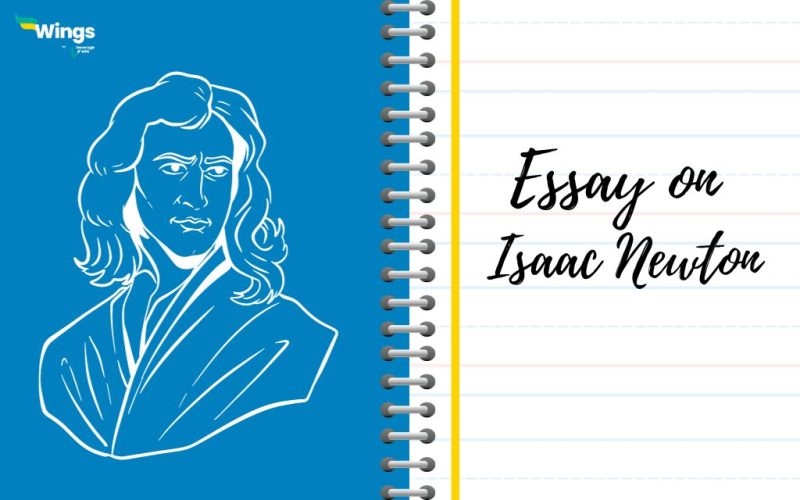Did you know Isaac Newton almost gave up on his education before discovering the laws of motion? Born in 1642, Isaac Newton was an English mathematician, physicist, astronomer, and author who is widely recognized as one of the most influential scientists in history. He is known as the father of modern physics. He made significant contributions to various fields of science and mathematics, and his work laid the foundation for many scientific principles and discoveries. Let’s find out more about Isaac Newton with the essays written below.
Table of Contents
Also Read – Essay on Chandrayaan-3
Things to keep in Mind while Writing Essay on Isaac Newton
- Isaac Newton was born on 4th January 1643.
- He is famous for discovering the phenomenon of white light integrated with colours which further presented as the foundation of modern physical optics.
- He is known for formulating the three laws of motion and the laws of gravitation which changed the track of physics all across the globe.
- In mathematics, he is known as the originator of calculus.
- He was knighted in 1705 hence, he came to be known as “Sir Isaac Newton”.
Essay on Isaac Newton in 100 Words
Issac Newton was an English scientist who made some groundbreaking discoveries in the field of science and revolutionized physics and mathematics. revolutionized physics and mathematics. He formulated the three laws of motion, defining how objects move and interact with forces. His law of universal gravitation explained planetary motion. Newton independently developed calculus, a fundamental branch of mathematics.
Everybody knows Newton because of the apply story, in which he was sitting under a tree when an apple fell on him. His ‘Philosophiæ Naturalis Principia Mathematica’ remains a cornerstone of scientific thought. Newton’s profound insights continue to shape our understanding of the natural world.
Also Read – Essay on Technology
Essay on Isaac Newton in 200 Words
Born in 1642, Isaac Newton is one of the most influential scientists of all time. His groundbreaking contributions in physics, astronomy and mathematics helped reshape the understanding of the natural world. Our science books mention Newton’s three laws of motion which brought a revolution in physics.
- Newton’s first law of motion, also known as the law of inertia, states that an object will stay at rest unless acted upon by an outside force.
- The second law of motion states that an object’s acceleration is produced by a net force that is directly proportional to the net force’s magnitude.
- The third law of motion states that every action has an equal and opposite reaction.
All these laws laid the foundation for classical mechanics, revolutionizing the way we comprehend the physical world. He is known as the father of modern physics.
In mathematics, Newton developed calculus independently. His work in calculus was essential for solving complex mathematical problems, making it a cornerstone of modern mathematics and science.
His work ‘Philosophiæ Naturalis Principia Mathematica’ was published in 1687, and remains a monumental work that underpins modern science. His profound insights continue to shape our understanding of the universe, making Isaac Newton one of history’s most influential and celebrated scientists.
Essay on Isaac Newton in 300 Words
Isaac Newton was an English scientist who was known for his groundbreaking discoveries in the fields of Physics, Mathematics and Astronomy. Thanks to his discoveries of revolutionizing our understanding of the natural world.
One of his well-known discoveries was the three laws of motion, also known as Newton’s three laws of motion.
- The first law, known as the law of inertia, states that objects at rest tend to stay at rest, and objects in motion tend to stay in motion unless acted upon by an external force.
- The second law quantifies how forces affect an object’s motion, introducing the famous equation F = ma (force equals mass times acceleration).
- The third law, the law of action and reaction, explains that for every action, there is an equal and opposite reaction.
These laws provided a comprehensive framework for understanding and predicting the behaviour of physical objects, from the motion of planets to the fall of an apple.
Another groundbreaking achievement of Newton was the discovery of the universal law of gravitation. This law states that every object in the universe attracts every other object with a force directly proportional to their masses and inversely proportional to the square of the distance between them.
It explained the mechanics of planetary motion and demonstrated that the same laws that govern objects on Earth also apply to celestial bodies, unifying the terrestrial and celestial realms.
In mathematics, Newton independently developed a powerful mathematical tool, called calculus, for analyzing rates of change and solving complex problems. His work laid the groundwork for modern calculus and transformed mathematics, physics, and engineering.
Newton’s magnum opus, “Philosophiæ Naturalis Principia Mathematica” (Mathematical Principles of Natural Philosophy), published in 1687, is a landmark work that brought together his laws of motion and the law of universal gravitation.
FAQs
Issac Newton was an English mathematician, astronomer, theologian, alchemist, author and physicist, was known for the discovery of the laws of gravity, and worked on the principles of visible light and the laws of motion.
Newton’s three laws of motion are: first law of motion (law of inertia), which states that an object will stay at rest unless acted upon by an outside force; The second law of motion states that an object’s acceleration is produced by a net force that is directly proportional to the net force’s magnitude; The third law of motion states that every action has an equal and opposite reaction.
Issac Newton is known as the father of modern physics and was associated with Cambridge University as a physicist and mathematician.
For more information on such interesting topics, visit our essay writing page and make sure to follow Leverage Edu.
 One app for all your study abroad needs
One app for all your study abroad needs













